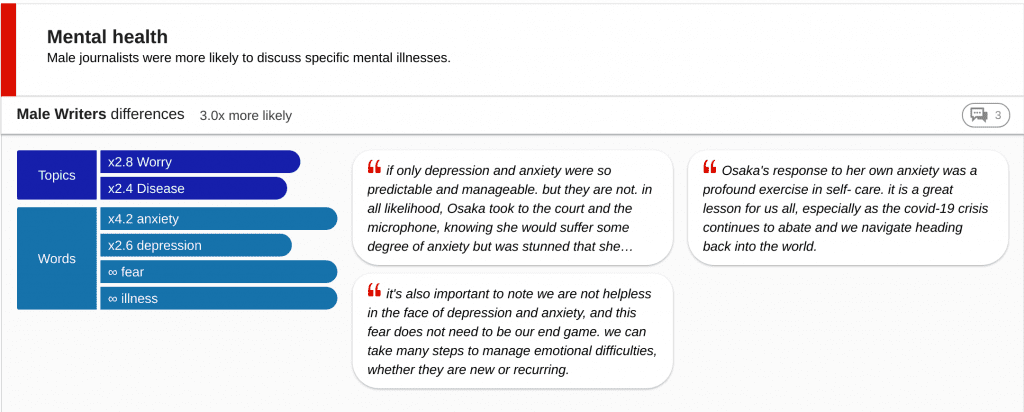How male and female journalists covered news of Naomi Osaka’s decision to quit

ICYMI: Naomi Osaka withdrew from the French Open, refusing to partake in press conferences in order to prioritize her mental health. After Piers Morgan’s disparaging comments – calling the athlete a “spoiled brat” – we wanted to dig a little into gender stereotypes about mental health issues.
We wanted to see if we could spot any differences in the way journalists report on the story, not by publication type – so whether they are right or left leaning, but by the gender of the writer.
First, we pulled current news and opinion articles from the US and UK discussing Naomi Osaka’s decision to leave the French Open. We then divided that selection of media coverage by the author’s gender. Using Relative Insight, we compared the language used by men and women to understand how gender impacts the words they use and narrative they portray.
Relative Insight utilizes comparative text analysis to reveal just what makes an audience, topic or brand stand out. Our natural language processing technology uncovers the words, phrases, grammar, topic and emotion unique to each written data set. This power gives us the insight to further understand gender bias in the media.
Female Journalists
We found that women took a much broader view in their writing than men, often commenting on how Naomi Osaka’s ‘openness’ speaks to larger gender and race issues. These journalists recognized that being a black woman put Osaka in a difficult position, making her further susceptible to increased criticism and scrutiny. This shows female writers are more socially aware of gender and race issues, potentially because they themselves face those obstacles.


Female writers looked to the future and pushed for the treatment of mental health in sports to change. Instead of merely reporting on the faults of sports organizations, these journalists insisted that better mental health practices be implemented to protect athletes.


We saw this theme of protection and safety repeatedly from the female reporters through the use of words like protected, guard and safety. Women are often characterized as nurturing – and while that’s not always accurate – these word choices support an image of protective female figures.
Women viewed this mental health battle more seriously than their male counterparts, using words like prioritize, sacrifice and dedicate. These are strong, action-oriented word choices used to relay the gravity of Osaka’s decision and the larger mental health fight athletes face.
We observed accountability from the female writers, who discussed the role of the media and interviews on Osaka’s mental wellbeing. These writers are the very individuals who contributed to the high pressure environment that caused Osaka to withdraw, but they acknowledged their role and took accountability.
Male Journalists
None of the other male writers we analyzed held as extreme opinions as Piers Morgan, but they did view Naomi’s decision very differently from their female counterparts. There appeared to be less opinionated commentary and more factual reporting, which we observed through the use of clinical mental health terms like anxiety and depression.


Men proved to be caught off guard by Naomi Osaka’s decision, using words like shocked and stunned. This implies that men and women have different views on the importance of mental health. It appears that men couldn’t believe that someone would forgo a high-level international competition to protect their mental health – while women showed care for the severity of the issue and the importance of personal safety.
Male writers characterized mental illness and the fight for better mental health practices as a struggle. Although men were less likely to discuss change, struggle typically implies effort and a desired outcome. This word usage shows similar intent, but the message is portrayed with less emphasis.
Overall, male journalists did not approach Naomi Osaka’s decision with increased criticism – but they did lack the direct language and seriousness women brought to the discussion. Female writers understood the nuances of the situation, remaining firm in their beliefs and insistence for change.
